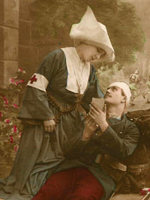After Hiroshima: The Question of Nuclear Weapons
Mayor of Hiroshima Tadatoshi Akiba describes the effects of the nuclear bombing of Hiroshima on the city and on the lives of the survivors, and calls for nuclear disarmament.
Mayor of Hiroshima Tadatoshi Akiba describes the effects of the nuclear bombing of Hiroshima on the city and on the lives of the survivors, and calls for nuclear disarmament.
Vietnam War veteran Robert Vinson talks about his experiences in Vietnam and returning home on leave during the war and after his service in the war, including his struggle with PTSD and use of massage and movement therapy.
Professor Martha N. Gardner looks at the life of Lucy Ellen Sewall (1837-1890), a 19th-century Boston medical doctor, who worked for better care for motherless infants, including at the Massachusetts Infant Asylum. Gardner examines medicine in the 19th century and the role of women in medicine. Her presentation includes slides.
From the PBS Video website:
"In the summer of 1950 Wytheville, VA realized the nation's worst medical fears. An outbreak of Infantile Paralysis, commonly known as Polio, swept through a small town of 5,500 in which 40 percent of residents had not yet reached their eighteenth birthday. Highly contagious, just in time for summer vacation, the devastating neurodegenerative disease had chosen its next target."
This full-length documentary traces the progress of the mid-20th-century polio scare, the campaign to find a cure, and the development of two vaccines.
The East Tennessee Historical Society seeks to preserve and share the unique history of Eastern Tennessee and its people. To this end, the society operates the Museum of East Tennessee History. Permanent exhibits include a historical overview off the area, addressing the Cherokee, frontier life, the Civil War, the Great Smokey Mountains National Park, the Tennessee Valley Authority, country music, and the Civil Rights Movement. The museum also presents a recreated early 20th-century streetscape, including period dentist and drug store settings and an original streetcar.
The society offers exhibits, period rooms, genealogy workshops, school tours and scavenger hunts, curriculum-based programs, curriculum-based outreach programs, and educator workshops and summer institutes. The website offers lesson plans and genealogy resources for use in the classroom.
The Deshler-Morris House, or Germantown White House, is the oldest official presidential residence. It was utilized by George Washington during the 1793 Philadelphia outbreak of Yellow Fever and the following summer.
The house offers exhibits and period rooms.
The Central Sierra Historical Society and Museum, Inc. is a 501 (c)(3) public benefit corporation with a membership of over 500 individuals, businesses, and organizations. This grassroots endeavor was the catalyst for the Central Sierra Historical Society, which identified as part of its mission the creation of a regional history museum. CSHS launched the Museum of the Central Sierra with a major media event in 1998. In addition to museum building, CSHS is actively preserving local historical treasures, such as the Pine Logging Camp and a 1912 caboose from the SJ&E Railroad and collecting the oral histories of area pioneers.
The site offers information about the society and contains coverage of past events.

The Community of the Sisters of Charity, an order of the Congregation of the Mission founded by St. Vincent De Paul and dedicated to teaching and nursing, was founded in the U.S. in 1809 by St. Elizabeth Seton (1774-1821). This collection of 580 postcards "documents the spirituality and mission of the Vincentians" and includes images of institutions such as hospitals, churches, and seminaries in many U.S. states including California, Illinois, Indiana, Kansas, Kentucky, Louisiana, Missouri, Maryland, and Massachusetts. "Spanning 200 years, these postcards reflect the heritage of the religious orders, the growth of social institutions, advancements in technology, and changes in urban environments." Visitors can browse the full collection or use advanced and simple searches to locate images of particular interest. Full bibliographic information accompanies each image. This archive is of interest to anyone researching the history of religious institutions in 19th- and 20th-century America.
Author John M. Barry discusses the global flu outbreak of 1918, which is estimated to have killed from 50 to 100 million people worldwide. He looks at the U.S. government's response to the outbreak, and considers the impact such an outbreak would have on the U.S. and the world today.
From the Gilder Lehrman Institute:
Charles Mann's most recent book, 1491, won the U.S. National Academy of Sciences' Keck Award for the best book of the year. In this lecture he looks at new research on pre-Columbian America. He concludes that the Americas had actually been heavily populated and developed before the arrival of Columbus but then were rapidly depopulated by the introduction of numerous European and African diseases, giving Europeans the mistaken idea that their new land was a vast, empty wilderness.